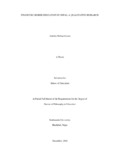
Please use this identifier to cite or link to this item:
https://hdl.handle.net/20.500.14301/106| Title: | FINANCING HIGHER EDUCATION IN NEPAL: A QUALITATIVE RESEARCH |
| Authors: | Joshee, Ambika Mohan |
| Citation: | Joshee, A.M. (2016). Financing Higher Education in Nepal: A Qualitative Research. [Unpublished Doctor of Philosophy Thesis]. Kathmandu University . |
| Issue Date: | Dec-2016 |
| School: | SOED |
| Department: | DODE |
| Level: | Ph.D. |
| Program: | PhD in Development Education |
| Abstract: | Nepal does not have a long history of higher education. Both Tribhuvan University (TU) and Nepal Sanskrit University (NSU) were established with full government financial support. These universities charge minimum and reasonable tuition and other fees. Even with these minimum fees, higher education was just a dream for people from lower financial brackets and people residing in rural areas of the country. TU opened constituent campuses in many district headquarters and big cities which facilitated the rich and the city dwellers to access to higher education but lower middle class population, residing in the rural nooks and crannies of the country, had no access to higher education. Even after almost a century of the opening of the first institution of higher education, Nepal has not been able go very far in both quality and quantity. As public higher educational institutions did not meet the accelerating demand of education conscious public, private institutions started cropping up. With the start of the free market, many Nepali entrepreneurs saw the opportunity of their business in the educational field. They started opening schools and colleges left and right. These private institutions had to charge onerous tuition and other fees to survive as they got minimum financial support from the government. Along with these private colleges came the private medical institutions. Financial management issues started coming up due to the political interferences in hiring of high level personnel and management system in educational institutions. Universities and campuses with programs on soft science, business and other subject areas also had to face financial austerity due to low government support. Cost diversification in higher education finance has been happening in Nepal since the inception of higher education institutions. Cost sharing practices have not been planned scientifically. Students pay some fees in all institutions including all public campuses. Besides these government support, tuition and other fees, there are many virgin areas of financing that Nepali institutions of higher education have not even thought about tapping. A qualitative method has been applied to do research work and purposive sampling has been used under interpretive paradigm to do in-depth interviews. I have spent long hours with my research participants and I have also made several trips until the data was saturated. A coding system has been applied to keep all the research participants anonymous. Data have been reviewed and interpreted without any biases. In this study, the main characteristics of higher education finance in Nepal have been reviewed and the major activities to facilitate higher education finance and management of higher education finance have been discussed. An attempt has been made to see what course can be taken to address the current situation of higher education finance in Nepal. Nepal may have to choose different financing options with student friendly schemes to meets its need of diversified and technically savvy human capital. Proper use of the findings will have long lasting implications on the all-round development of higher education in Nepal. |
| URI: | http://101.251.6.110:8080/handle/20.500.14301/106 |
| Appears in Collections: | Research Project |
Files in This Item:
| File | Description | Size | Format | |
|---|---|---|---|---|
| Ambika Mohan Joshee, PhD.pdf | 2.52 MB | Adobe PDF |  View/Open |
Items in DSpace are protected by copyright, with all rights reserved, unless otherwise indicated.